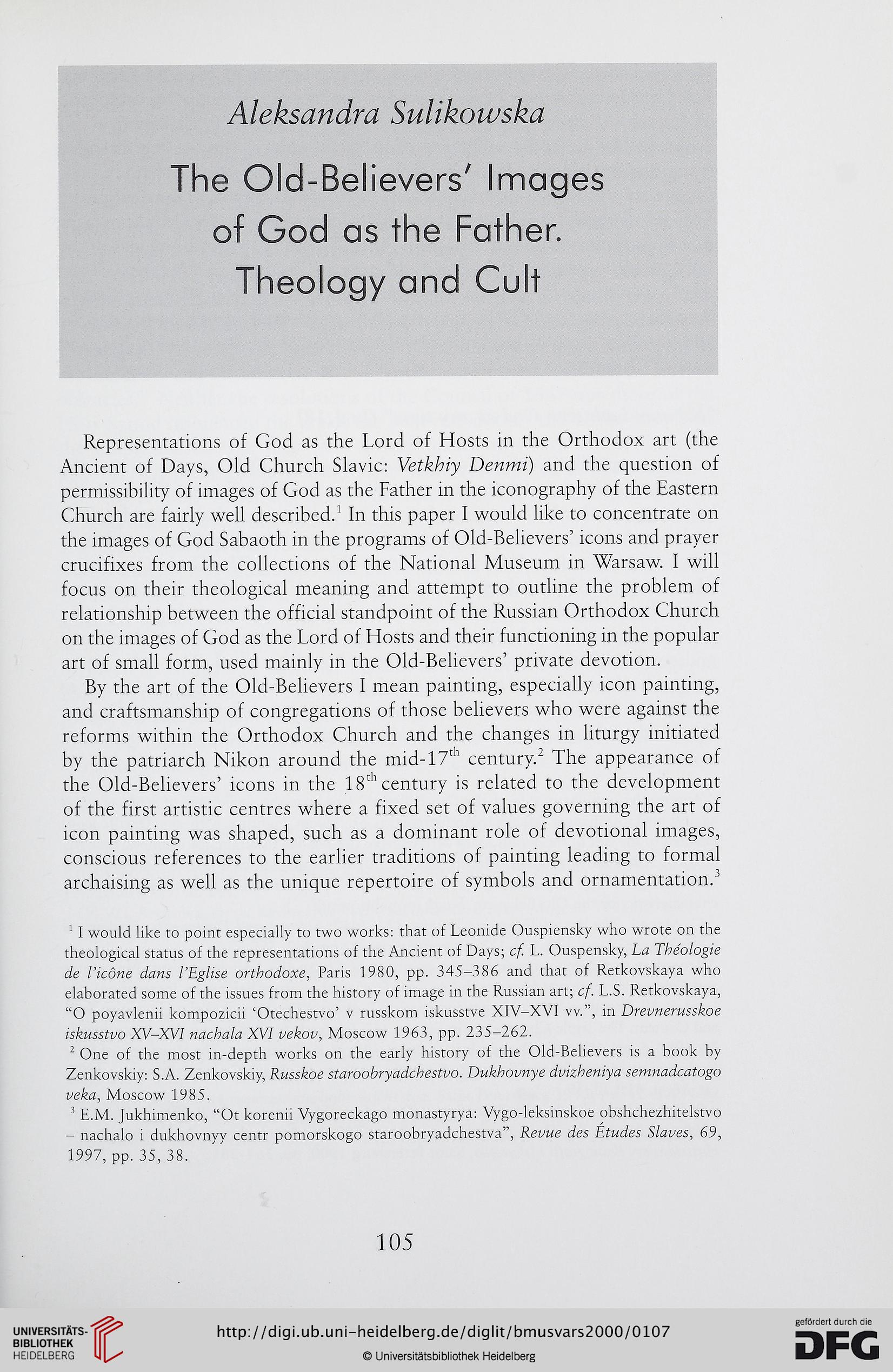Aleksandra Sulikowska
The Old-Believers' Images
of God as the Father.
Theology and Cult
Representations of God as the Lord of Hosts in the Orthodox art (the
Ancient of Days, Old Church Slavic: Vetkbiy Denmi) and the ąuestion of
permissibility of images of God as the Father in the lconography of the Eastern
Church are fairly well described.1 In this paper I would like to concentrate on
the images of God Sabaoth in the programs of 01d-Believers’ icons and prayer
crucifixes from the collections of the National Museum in Warsaw. I will
focus on their theological meaning and attempt to outline the problem of
relationship between the official standpoint of the Russian Orthodox Church
on the images of God as the Lord of Hosts and their functioning in the popular
art of smali form, used mainly in the 01d-Believers’ private devotion.
By the art of the 01d-Believers I mean painting, especially icon painting,
and craftsmanship of congregations of those believers who were against the
reforms within the Orthodox Church and the changes in liturgy initiated
by the patriarch Nikon around the mid-17th century.2 3 The appearance of
the 01d-Believers’ icons in the 18lh century is related to the development
of the first artistic centres where a fixed set of values governing the art of
icon painting was shaped, such as a dominant role of devotional images,
conscious references to the earlier traditions of painting leading to formal
archaising as well as the uniąue repertoire of symbols and ornamentation.’
1 I would like to point especially to two works: that of Leonide Ouspiensky who wrote on the
theological status of the representations of the Ancient of Days; cf. L. Ouspensky, La Theologie
de 1’icóne dans 1’Eglise orthodoxe, Paris 1980, pp. 345-386 and that of Retkovskaya who
elaborated some of the issues from the history of image in the Russian art; cf. L.S. Retkovskaya,
“O poyavlenii kompozicii ‘Otechestvo’ v russkom iskusstve XIV-XVI w.”, in Drevnerusskoe
iskusstvo XV-XVI nachala XVI vekov, Moscow 1963, pp. 235-262.
2 One of the most in-depth works on the early history of the 01d-Believers is a book by
Zenkovskiy: S.A. Zenkovskiy, Russkoe staroobryadcbestvo. Dukhovnye dvizheniya semnadcatogo
veka, Moscow 1985.
3 E.M. Jukhimenko, “Ot korenii Vygoreckago monastyrya: Vygo-leksinskoe obshchezhitelstvo
- nachalo i dukhovnyy centr pomorskogo staroobryadchestva”, Remie des Etudes Slaves, 69,
1997, pp. 35, 38.
105
The Old-Believers' Images
of God as the Father.
Theology and Cult
Representations of God as the Lord of Hosts in the Orthodox art (the
Ancient of Days, Old Church Slavic: Vetkbiy Denmi) and the ąuestion of
permissibility of images of God as the Father in the lconography of the Eastern
Church are fairly well described.1 In this paper I would like to concentrate on
the images of God Sabaoth in the programs of 01d-Believers’ icons and prayer
crucifixes from the collections of the National Museum in Warsaw. I will
focus on their theological meaning and attempt to outline the problem of
relationship between the official standpoint of the Russian Orthodox Church
on the images of God as the Lord of Hosts and their functioning in the popular
art of smali form, used mainly in the 01d-Believers’ private devotion.
By the art of the 01d-Believers I mean painting, especially icon painting,
and craftsmanship of congregations of those believers who were against the
reforms within the Orthodox Church and the changes in liturgy initiated
by the patriarch Nikon around the mid-17th century.2 3 The appearance of
the 01d-Believers’ icons in the 18lh century is related to the development
of the first artistic centres where a fixed set of values governing the art of
icon painting was shaped, such as a dominant role of devotional images,
conscious references to the earlier traditions of painting leading to formal
archaising as well as the uniąue repertoire of symbols and ornamentation.’
1 I would like to point especially to two works: that of Leonide Ouspiensky who wrote on the
theological status of the representations of the Ancient of Days; cf. L. Ouspensky, La Theologie
de 1’icóne dans 1’Eglise orthodoxe, Paris 1980, pp. 345-386 and that of Retkovskaya who
elaborated some of the issues from the history of image in the Russian art; cf. L.S. Retkovskaya,
“O poyavlenii kompozicii ‘Otechestvo’ v russkom iskusstve XIV-XVI w.”, in Drevnerusskoe
iskusstvo XV-XVI nachala XVI vekov, Moscow 1963, pp. 235-262.
2 One of the most in-depth works on the early history of the 01d-Believers is a book by
Zenkovskiy: S.A. Zenkovskiy, Russkoe staroobryadcbestvo. Dukhovnye dvizheniya semnadcatogo
veka, Moscow 1985.
3 E.M. Jukhimenko, “Ot korenii Vygoreckago monastyrya: Vygo-leksinskoe obshchezhitelstvo
- nachalo i dukhovnyy centr pomorskogo staroobryadchestva”, Remie des Etudes Slaves, 69,
1997, pp. 35, 38.
105




